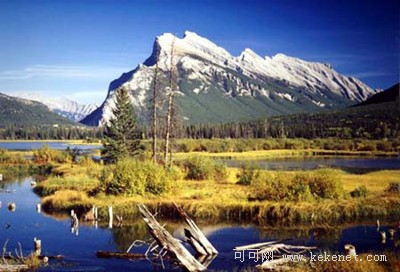(单词翻译:单击)
听力原文
我们上一次的收获是16亿年前的叶子化石,那么发现了它意味着什么呢?低温度下的叶子与温暖环境中的叶子相比,它们的叶缘上面会有什么样的变化呢?这是值得探讨的。接着听哦!

Leaves with teeth do better in colder climates because teeth are actually really advantageous in jump-starting growth at the beginning of the growing seasons. In this case, you can see this beautiful fossil leaf here with teeth, and each of the teeth are a little hotbeds of photosynthesis(光合作用), so when that leaf first comes out of the bud, it gets a jump-start on leaves that don't have teeth.
Miller uses this information to find out about the height of the young Rocky Mountains. In a simple but powerful technique, he compares the number of leaves with teeth to those without.
You go to a particular area, and you pick up all the species of leaves that are there from the trees that are growing in that area, and you compare the number of species that have teeth to the number of species that have smooth margins. That gives us some idea of what the temperature is.
So the higher the proportion of plants with jagged edges compared to plants with smooth edges, the colder the temperature of the site. And the colder the temperature, the higher the mountain.
So if you've got into a hot air balloon here today, and you float it straight up into the atmosphere, the temperature will decrease in a very predictable way, and it turns out that for about every mile you go up in the atmosphere, you lose about 20 degrees Fahrenheit. So if we know how temperature changes with elevation, we can back out elevation from those estimates of temperature.
To work out the height of the early mountain, Miller needs to compare samples from two areas, one at the base of the mountain and one at the top. Fossils found at the base of the Rockies near the present-day Denver have an amazing story to tell. These ancient leaves are incredibly similar to plants growing in the tropics today.
So after the Rockies rose, down in the area of Denver, it was sub-tropical and tropical forests, we have palms, and cycads, and canopies like we see in the tropics today. Up here we had a forest that looked probably more like a forest that grows in North or South Carolina on the east coast of the U.S.
By comparing the ancient fossil leaves from the top of the mountain with fossil leaves from the foot of the mountain, Miller has come up with a surprising conclusion.
It turns out that the fossil leaves here are predominantly toothed as compared to those that are in Denver which are predominantly smooth margin. And it turns out the ones in Denver grew in a climate that was about, on average about 75 degrees Fahrenheit, the ones up here grew in a climate that was probably about 50 degrees Fahrenheit. So if we know how temperature changes with elevation, that means that this site, when these fossil leaves were deposited, was about a mile higher than Denver. Today it's only a half mile higher. So 60 million years ago, the mountains would be twice as high as they are today.
小编有约:本期的文章中有许多对比的句子,非常的地道。可以摘抄下来,试着自己写作文的时候用。不仅仅是优美的文章,同时Daisy也认为它告诉了我们探索真理的一种方法。这种方法叫“比较研究法”,通过对近缘物种的行为进行对比分析,以了解行为适应和进化的重要方法。这是一种科学的研究方法。在学习物理和化生时,会用到这个方法。
课后题目:Daisy提供这三个线索,你来找找看这个答案。A. You've got into a hot air balloon. B.You float it straight up into the atmosphere. C. The temperature will decrease in a very predictable way.
听力答案
呵呵~~答案就是"It turns out that for about every mile you go up in the atmosphere, you lose about 20 degrees Fahrenheit."它在文章的哪一段呢?找找看哦!
参考译文
叶缘是齿状形的叶子更耐寒,因为这些齿状形的叶子在发芽的季节更容易成活。你再仔细地看这片美丽的叶子化石,它每一个齿状形的周边都可以进行光合作用。因此,当叶子出芽的时候,它就会比非齿状形叶片的叶子成活率高。
米勒利用这一信息,去找寻原始落基山脉的高度。这是个简单但是有用的方法,他把有齿状形叶片的数量和没有齿状形叶片的数量做比较。
去一个特定的区域,摘下该地区所有树上不同种类的树叶,然后比较该地区齿状形树叶物种的数量。我们就可以知道这儿的温度。
齿状形树叶的植物比例高时,该地区的温度也就越冷。温度越冷,山就愈高。
如果今天你就坐在热气球里,在这儿会直线上升飘到大气层中,可以预见温度会不断的下降。事实也证明,在大气中每上升一英里,就下降华氏20度左右。因此,只要我们知道了温度与海拔的关系,我们就可以根据温度的变化,倒推出落基山的高度。
想要估算出原始落基山脉的高度,米勒需要比较两个地方的标本,一个在山脚,一个在山顶。在山脚发现的化石可有着耐人寻味的故事。因为这些古老的叶子与今天热带地区植物的叶子是惊人的相似。真的让人难以置信。
从此以后,落基山脉继续上升。而在丹佛地区的森林成为一个亚热带和热带的森林。在这里面有棕榈树,苏铁和檐篷,简直和我们今天看到的热带植物一模一样。而山上边的森林看上去更像是美国东海岸的北卡罗来纳州或南卡罗来纳州的森林。
通过与山脚的化石相比较,米勒得出了一个惊人的结论。
原来,山顶的叶子化石主要是齿状形的叶子,而在丹佛,大部分都是叶缘光滑的叶子。 事实证明,在丹佛的气温平均约为75华氏度,到了山顶气候可能就是华氏50度左右。 如果我们知道了海拔高度与温度变化的关系,也就意味着,比较了山顶与山脚的叶子化石,就推测出山顶比丹佛大约高一英里。而在今天,它只高半英里。所以在60万年前,这儿山的高度应该是今天的两倍。
以上的译文仅供参考,如果有不妥之处,请大家指出。呵呵~~,Daisy在这里谢谢大家啦。为了保证这个栏目的质量,以后就是每两天一期。谢谢大家的支持!
重点讲解
注释:① jump-starting n. 借火;起动 v. 起动(jump-start的ing形式)
例句:
1. What we are doing is jump-starting these concepts and demonstrating their potential.
我们现在做的是跳跃性的展示这些概念和潜力。
2. Maybe the economic measures already taken will end up doing the trick, jump-starting a self-sustaining recovery.
或许现有的经济措施最终会发挥预期的效果,推动经济的持续发展。
② pick up 捡起;获得;收拾
例句:
1. I'd really like to pick up Grandpa at the railroad station.
我真想去火车站接爷爷。
2. I'll go to pick up some odds and ends at the store.
我要到商店买些零碎的东西。
3. She soon picked up French when she went to live in France.
她到法国居住后很快就学会了法语。
③ turn out v. 结果是, 生产, 出现, 关闭, 翻转, 证明是
例句:
1. Remember to turn out the lights before you go to bed.
临睡前别忘了关灯。
2. The news turned out to be false.
那个消息后来证明是假的。
句子讲解:
1. You go to a particular area, and you pick up all the species of leaves that are there from the trees that are growing in that area, and you compare the number of species that have teeth to the number of species that have smooth margins.
【结构简析】 由"and"连接的两个句子,这些动作是自然而然发生的。你到了一个地方,先是 "pick up" 摘叶子然后就是"compare"这些叶子。其他成分是用来说明这些叶子的修饰成分。
【参考译文】 去一个特定的区域,摘下该地区树上所有不同种类的树叶,然后比较该地区齿状形树叶物种的数量。
2. So if you've got into a hot air balloon here today, and you float it straight up into the atmosphere, the temperature will decrease in a very predictable way, and it turns out that for about every mile you go up in the atmosphere, you lose about 20 degrees Fahrenheit.
【结构简析】这个长句子要表达的意思非常的简单,就是你愈往上走,就愈感觉到冷。
【参考译文】如果今天你就坐在热气球里,在这儿你会直线上升飘到大气层中,可以预见温度会不断的下降。事实也证明,在大气中每上升一英里,就下降华氏20度左右。


